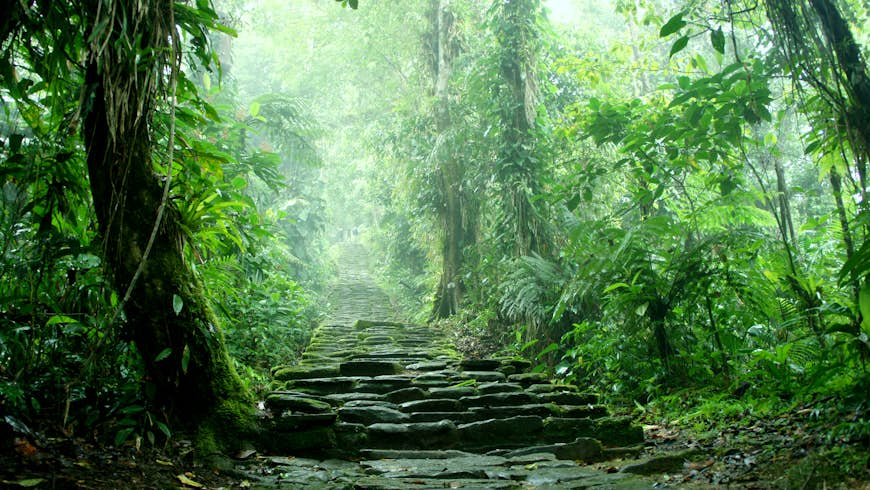With a durable peace deal in place and an ever-growing number of international visitors, Colombia has seen a total transformation in recent years.
Hemmed in by the Caribbean and Pacific coastlines in the north and west and the Amazon rainforest in the south, Colombia contains some of South America’s most spellbinding scenery and thrilling adventures. Wildlife-rich jungle, startlingly rugged high-altitude mountain paths and thriving coral reefs flush with tropical fish can be experienced all on one (ambitious) trip. Meanwhile, away from the wilds, modern cities brim with music, culture and welcoming people.
For the curious, open-minded traveler, it’s difficult to not fall in love with this country – and even harder to leave. Whether you’re seeking culture, adventure, history or showstopping nature, here are the top things to do in Colombia.
Raft the Rio Pato with ex-FARC guerillas
Splashing down through the Class III and IV rapids of the Río Pato in the Caquetá Department is an exhilarating experience. And the excitement only grows once you realize your guides are a mix of ex-FARC guerillas and civilians, who use rafting as a means to challenge perspectives about a region of Colombia that was too dangerous to visit during the decades of conflict.
Tucked deep into the tropical forests in southeast Colombia, the hillside village of Miravalle is home to local tour operator Caguán Expeditions, which leads rafting trips down what’s considered one of the country’s finest stretches of river for whitewater rafting. A community-operated museum offers details of the day-to-day experiences of FARC rebels before the historic peace accords agreed with the Colombian government in 2016 took place, and gives you an insight into the lives of those being reintegrated back into Colombian life after decades of armed conflict.
Discover the world’s most intriguing experiences with our weekly newsletter delivered straight to your inbox.
Tramp through the jungle to Ciudad Perdida, Colombia’s Machu Picchu
Ever dreamed of being an explorer? Hiking through lush tropical vegetation for three days before you even catch a glimpse of Colombia’s deservedly named Ciudad Perdida (Lost City) is an opportunity to experience the very same thrill.
The muddy, ascending trails and humid temperatures of the jungle mean it’s a challenge to get here, but you’ll feel all the sweat was worth it (the tears, too!). A truly magnificent pre-Columbian city, Ciudad Perdida was built atop a ridge in the northern stretches of the Sierra Nevada de Santa Marta by the Tayrona people more than 1000 years ago. Today, the site remains all but devoid of visitors.
It’s no wonder: it’s a tough five-day round-trip hike to reach the site, and one of the most adventurous things to do in Colombia. Along the way, refreshing swimming holes and striking jungle scenery ensure your efforts are fully rewarded.
Learn to salsa in dance-capital Cali
Staking its claim as the world capital of salsa, party-loving Cali is a riot of music and dancing, whatever the time of day or night. Embrace the fluidity of your hips as you embark on a brief but overwhelming love affair with Colombia’s favorite dance step, whether you head to a dance school or go with the flow and rhythms at one of the city’s famed salsotecas, such as La Topa Tolondra or the local favorite El Rincón de Heberth.
If visiting during September, don’t miss the Festival Mundial de Salsa, where a raucous seven days sees more than 5000 dancers from around the world descend on the city in a fiercely contested competition to identify the world’s greatest salsa dancer.
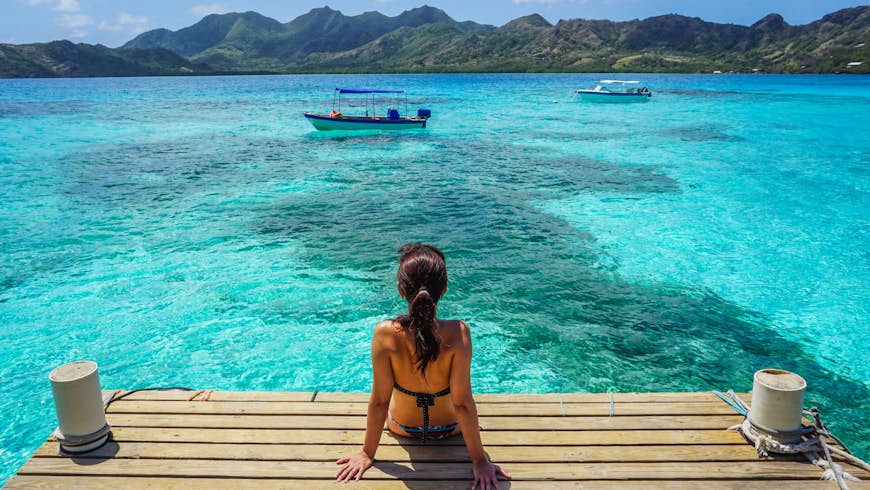
Snorkel in the coral reef surrounding Providencia
Colombia’s Caribbean coastline feels like paradise – and that description applies even more to emerald-green Providencia, a mellow tropical island that spans just 17 km sq (6.6 sq miles) and lies around 800 km (497 miles) north of mainland Colombia.
Lying off the northeast coast of the island, the McBean Lagoon National Natural Park is characterized by waters tinted with a glorious patchwork of colors. It’s been dubbed the “Sea of Seven Colors,” a phenomenon caused by the third-longest barrier reef system on the planet lying beneath the surface. Explosions of tropical fish, manta rays and even sea turtles are ever-present in these waters, which are crystal clear and bathtub warm, making this one of the best places in Colombia for snorkeling.
Join the party at the Carnival de Barranquilla
Colombia’s most enthusiastic street party can be found in the pulsating streets of Barranquilla during the city’s annual Carnival celebrations. Kicking off officially on the four days before Ash Wednesday every February or March (although smaller verbenas – pre-Carnival public parties – begin some 10 days beforehand), these celebrations offer an enthusiastic display of pageantry, comprising four packed days of carnival floats, beauty queens, African and Indigenous beats and – in true Colombian fashion – plenty of dancing.
The Carnaval de Barranquilla so integral to the identity of the city that the event was declared an Intangible Cultural Heritage by Unesco in 2008. It ranks among the continent’s liveliest carnival celebrations, up there with Rio de Janeiro’s festivities and those held in Oruro in Bolivia. Throw yourself into the dancing and you may even wind up joining a local dance troupe on their float, which could well end up being one of the craziest things you do in Colombia – and one of the most memorable things you’ll do, ever.
Discover Cartagena’s Indigenous heritage
The picturesque walled city of Cartagena feels like a movie set, with its historic plazas, majestic churches and restored mansions that have been converted into swank boutique hotels and restaurants serving up Caribbean-infused seafood dishes.
But beyond Cartagena’s colonial opulence – built off the back of the slave trade and Spanish plunder, it’s important to consider – the city has a whole different side, one tourists rarely see. At the Museo del Oro Zenú, you’ll see displays of gold artifacts from the Indigenous people who were the original inhabitants of the Cartagena region. Today, weavers from this community continue to produce the traditional Colombian sombrero vueltiao hat, which can be bought at market stalls around the city.
To meet community representatives in person and learn about the challenges they face as a culture in modern Colombia, take part in a community-led city tour.
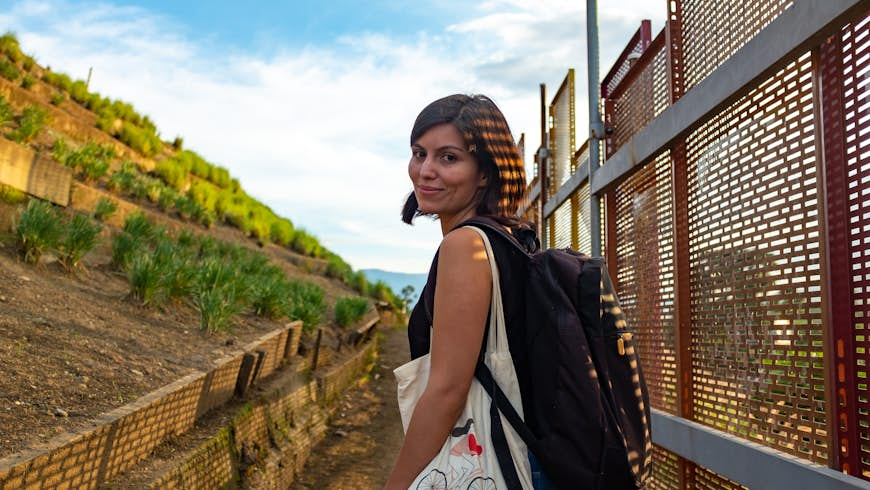
Learn about Medellín’s extraordinary transformation
Whether it’s Netflix’s Narcos or reports from the ’90s that have colored your perceptions, prepare to be astounded by the reality of modern Medellín. Having shed the cloak of drug-incited conflict, Medellín is a city transformed, with such modern neighborhoods as Poblado and Laureles showcasing upmarket restaurants and vibrant nightlife – proof that a leopard can change its spots.
To get under the skin of the city’s urban regeneration and checkered past, take a tips-based walking tour with Real City Tours, whose local Paisa guides have lived through the metamorphosis and can talk with authority about the city’s rebirth. Their tour of the former rubbish dump–turned–thriving neighborhood of Moravia is similarly enlightening.
Photograph Colombia’s national plant in the Valle de Cocora
Located in the lower reaches of Parque Nacional Natural Los Nevados, one of the best national parks to visit in Colombia, the Valle de Cocora is one of Colombia’s most fantastical destinations. It preserves some of the final snow-topped tropical mountains on Earth, and it’s home to the country’s curiously shaped Quindío wax palms, which can reach the height of a six-story building and which tower over this lush valley.
Take a Willy Jeep (an experience in itself) from nearby Salento into the valley, from where a 15km (9-mile) hike heads up into the hillside for spectacular views of the palms, picturesquely surrounded by emerald hills blanketed with cloud forest.
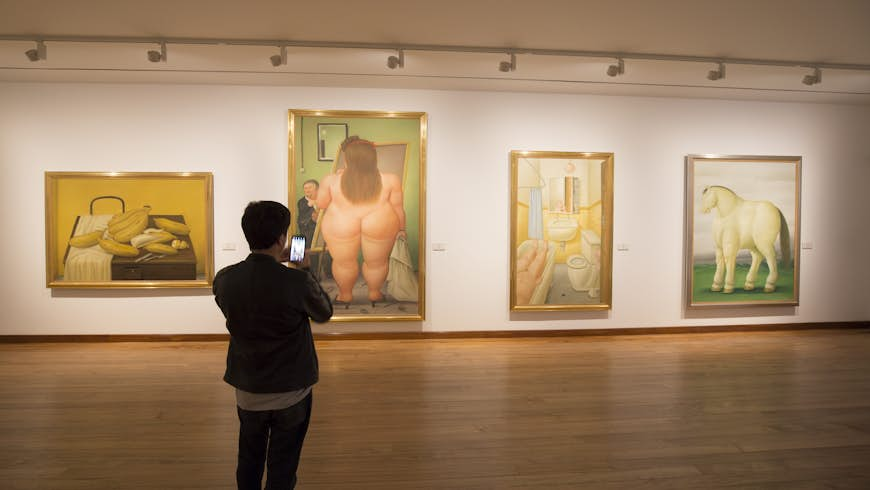
Explore Bogotá’s art and museum scene
Bogotá is a city whose initial impressions belie what lies beneath the surface. While its gridlocked streets, often slick with rain, might take some time to traverse, the capital of Colombia is a cosmopolitan city packed with dynamic nightlife and a rich range of cultural offerings.
A staple of the city’s cultural scene, the Museo del Oro displays a thousands-strong array of pre-Hispanic gold artifacts to gawk at. Similarly crucial in the canon of Colombian cultural history is the Museo Botero, a museum dedicated to Colombia’s most famous artist, known around the world for his humorously engorged figures.
For a taste of more contemporary creations, head to the stylish La Balsa gallery, or take a graffiti walking tour with Bogotá Graffiti Tour, which uses proceeds from tips-based excursions to invest in community projects around the country.
Stay on a coffee finca and sample Colombia’s tastiest export
World-class coffee is one of Colombia’s most important exports, and coffee addicts will find their home-away-from-home in one of the coffee fincas located in the lush hills in the Zona Cafetera.
Established fincas such as the fourth-generation Hacienda Venecia near Manizales allow you to learn about the production of the bean and try “cupping,” the act of tasting the flavors of freshly made coffee. But beware: you might struggle to enjoy a cup elsewhere after trying some of the world’s finest coffee beans at their source.
Take a road trip to La Guajira, South America’s northern tip
After the lush plantations of the coffee region, La Guajira is an assault on the senses. This arid desert peninsula that spears out into the Caribbean Sea on the very tip of the South American continent is home to some of the country’s most dramatic terrain.
The main attractions include the glorious ocher sand dunes of Punta Gallinas and Cabo de la Vela, which has ideal conditions for windsurfing and kitesurfing. Although independent travel is possible, it’s easiest to organize a tour from the regional capital, Riohacha.
One of the most impoverished parts of Colombia, this region is home to the semi-nomadic, Indigenous Wayúu, a people renowned for their weaving and whose ways of life and access to water are threatened by Latin America’s biggest open mine. Ensure your money goes into local hands by purchasing local handicrafts and using sustainable operators such as Pura Guajira Travel, who employ Wayúu guides.
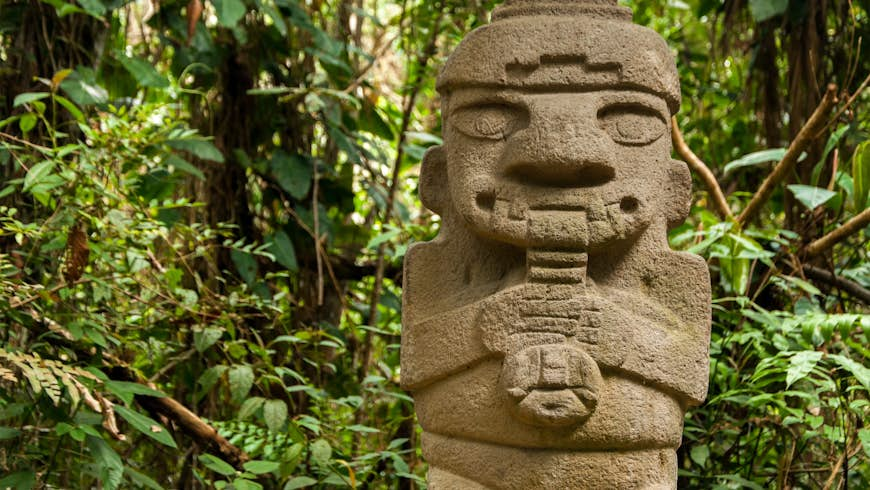
Explore South America’s largest concentration of religious figures
While Chile’s Rapa Nui (Easter Island) is known internationally for its monolithic statues, Parque Arqueológico San Agustín in southwestern Colombia lays claim to the largest clutch of pre-Columbian sculptures in South America. Archeologists still don’t know much about the culture dating back to between 5 and 400 CE that carved hulking bodies and fanged, animalistic faces from volcanic tuff. Located around the park, these figures mark the tombs of the culture’s dead. Home to more than 50 burial sites, the archeological park is an enthralling (if mysterious) insight into a culture for whom death was merely a transition into another life and where funeral rites were a significant ritual.
Another site believed to have been built by the same culture is Tierradentro, also worth visiting if you’re in the area. This vast necropolis is believed to have been built between 600 and 900 CE and contains 162 enormous burial chambers whose walls are decorated with remarkably well-preserved and extremely complex geometric designs.
Sleep in a rustic thatch roof cabin in Parque Nacional Natural Tayrona
Want to kick back and enjoy Colombia’s wealth of gorgeous beaches? For sunseekers, swimmers and snorkelers alike, Parque Nacional Natural Tayrona on the country’s Caribbean coast is a real paradise, where white-sand beaches are lapped by crystalline waters and enclosed by tropical jungle filled with monkeys, toucans and wild cats.
More than 30 spectacular beaches are located within this park, although with deceptively strong currents posing a risk to life, just six are safe for swimming. For a relaxing couple of days, rent a hammock or a rustic thatch roof cabin right by the beach at Cabo San Juan or Cañaveral, from where you can wander to your beach of choice for a day of soaking up the sunshine.
Stargaze in the Mars-like Tatacoa Desert
With its Mars-like undulations of red clay, the red Tatacoa Desert looks like it could have been transposed from Chile’s Atacama. It’s actually a dry tropical forest, but what it does share in common with its Chilean neighbor is its global renown as a place for crystal-clear night skies, making it perfect for stargazing.
The area’s warm, dry climate is the key to the extraordinarily visibility. For a stargazing tour, visit the Observatorio Astronómico de la Tatacoa in Villavieja, a center built by a Colombian astronomer that contains the most telescopes in the area, thanks to donations from scientists around the world. The enthusiastic owner can introduce you to up to 88 official constellations on the clearest of nights.
You might also like:
13 best places to visit in Colombia to soak up salsa and sunshine
Colombia’s best beaches are a slice of South American perfection
Best national parks in Colombia for volcanoes, glaciers, scuba diving and more
